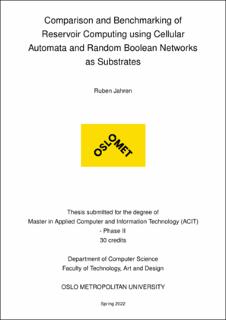Comparison and benchmarking of reservoir computing using cellular automata and random boolean networks as substrates
Master thesis
Published version
Permanent lenke
https://hdl.handle.net/11250/3017144Utgivelsesdato
2022Metadata
Vis full innførselSamlinger
Sammendrag
Reservoir Computing is an emerging concept in artificial intelligence derived from Recurrent Neural Networks, which utilizes an untrained reservoir substrate to memorize and separate input in such a way that it may be linearly separated in a readout layer.
Since its origins with RNN, it has shown great flexibility in what can be facilitated as a substrate.
In this thesis, Reservoir Computing models with Cellular Automata and Random Boolean Networks as substrates were implemented.
The Lifelike and Elementary CA rulespaces were explored on the X-bit Memory Benchmark with both substrates.
Efforts were made to discover how the innate differences in connectivity between CA and RBN would affect the performance of the reservoirs, and whether further exploration of RBN RC in conjunction with ReCA could bridge the gap between CA and biological neural networks as a substrate.
The RBN reservoirs used in this thesis showed tendencies to perform worse than CA for much of the explored rulespace, for the specific configurations tested on the X-bit Memory Benchmark. However, several rules exhibited interesting behaviour, an prompted further exploration and mapping of a shared rulespace between CA and RBN.
The results suggest that further exploration the parameterspaces and rulespaces of RBN RC in tandem with ReCA could facilitate the use of CA as an interface to biological substrates like BNN.
